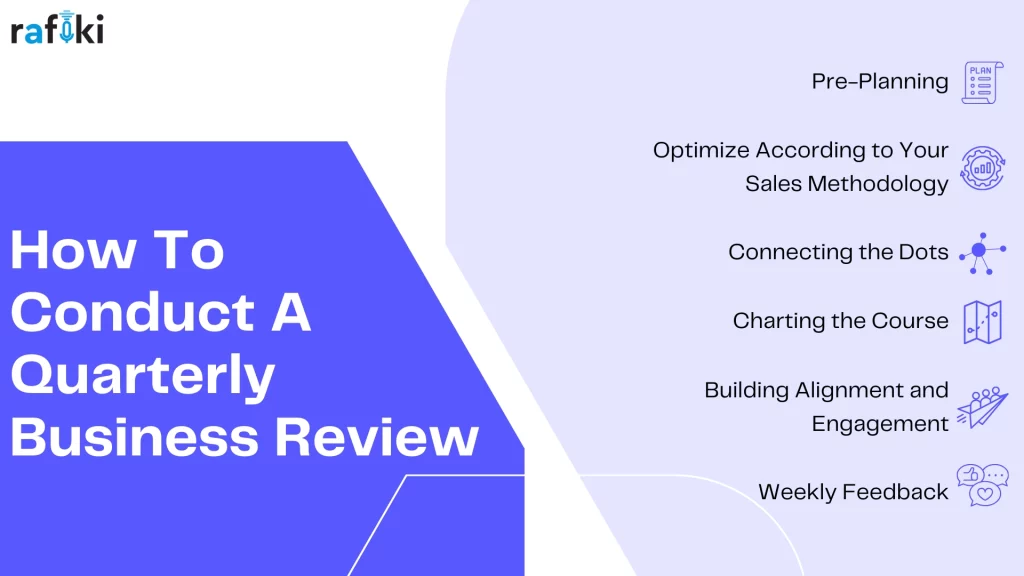Why Rafiki
Pricing


Pricing
Solutions

RevOps Leaders
Synchronize revenue generating functions

SDR Leaders
Get your team aligned and Coach your Reps 3x faster at scale

Sales Leaders
Unlock pipeline truth, drive confident forecasts

The moment you set the date for a QBR, a flurry of things happen in your sales team. For one, some people panic, thinking they’re about to be thrown to the wolves or exposed. Even those who’ve done a great job can feel this way. Imposter syndrome is real.
Some others gain focus & motivation. While others think “Great, it’s that time of the quarter again. Sigh.”.
As a sales leader, it’s important to understand how your people look at QBRs, how they should be looking at it and most importantly, how you can make QBRs effective. Most sales teams conduct QBRs but don’t stick to what they agree, later on in the quarter. This is because their leader didn’t conduct an effective review. They either failed to look at the past performance properly, gauge the future well, or ignored the present misalignment.
Conducting effective QBRs is not easy, but it is important. This comprehensive guide delves into the intricacies of conducting effective QBRs, equipping you with the knowledge and tools to navigate this crucial process with confidence.
Let’s dive in!
QBR, or Quarterly Business Review is a periodic meeting that brings together sales leaders, team members, and sometimes even key clients. This collaborative environment fosters a space for open dialogue around the team's performance. By dissecting the data and gleaning valuable insights, participants collectively chart a course for future growth and optimization.
However, the true power of QBRs lies not just in information sharing, but in actionable takeaways. QBRs equip your sales team with the knowledge and tools needed to consistently exceed expectations and propel your business forward.

While QBRs themselves are powerful tools, their effectiveness hinges on proper pre-planning. Here's where the groundwork is laid for a productive and insightful session.
Firstly, decide on the frequency of your QBRs. While quarterly reviews are the standard, some organizations opt for biannual or even monthly meetings depending on their specific needs. Next, prepare an executive summary that outlines key metrics, achievements, and challenges from the previous period. This concise document serves as a springboard for discussion and ensures everyone arrives on the same page. Finally, don't underestimate the power of sharing the agenda beforehand. This transparency allows participants to come prepared to contribute meaningfully and fosters a sense of ownership over the QBR process.
Keep in mind, a well-planned QBR is a well-run QBR. By investing time and effort upfront, you set the stage for an impactful session that propels your sales team towards achieving their full potential.
The beauty of the QBR framework lies in its adaptability. While the core principles remain consistent, specific sales methodologies may necessitate adjustments to ensure optimal effectiveness.
For instance, there's Solution Selling which emphasizes understanding a client's unique needs and crafting customized solutions. This methodology might benefit from a deeper focus on client pain points and win-loss analysis during the QBR. Conversely, Challenger Sale prioritizes challenging the status quo and presenting new perspectives. This might require a stronger emphasis on competitor analysis and value differentiation strategies.
By tailoring the QBR discussions to align with the chosen sales methodology, you empower your team to leverage its strengths and address challenges specific to their approach.
The heart of any effective QBR lies in scrutinizing the past quarter's performance with a critical eye. This involves delving into several key areas:
This data-driven introspection is crucial for unveiling hidden patterns and identifying trends that might not be readily apparent at first glance. By analyzing past performance with a critical yet objective lens, you gain invaluable insights that can inform future strategies.
Although the core focus of this stage should remain on fostering open communication, Rafiki can further aid in this process by providing insights across rep performance/deals/accounts. The objective evaluations and insights of Rafiki can streamline the process of connecting the dots of all your sales efforts.
Having unearthed valuable insights from the past, it's time to shift the focus towards the future. This is where the QBR transforms from a retrospective exercise into a strategic planning session.
Here, key activities include:
Before talking about building alignment, let's remind ourselves about the WHY.

See what I did there? It's important to talk about the WHY before WHAT. It is equally important to keep reminding the WHY, because people will forget it otherwise.
Now, a successful QBR isn't just about analyzing data; it's about fostering collaborative and engaged sales team. This section delves into strategies to achieve that:
By prioritizing transparency and open communication, you create a cohesive and motivated sales force that's well-equipped to tackle the challenges and opportunities that lie ahead.
While QBRs offer immense value, they're not without their challenges. Here are some common roadblocks and how to navigate them:
The QBR is not a one-time event; it's a continuous improvement cycle. By regularly revisiting, analyzing, and adapting your strategies, you empower your sales team to consistently refine their approach and achieve sustained success.
Track & Optimize Sales Performance
Keep in mind, effective QBRs are not just about looking back; they're about propelling your sales team forward towards a future filled with growth and achievement.
Explore how Rafiki can ensure your QBRs are effective by signing up for a free 14 day trial!